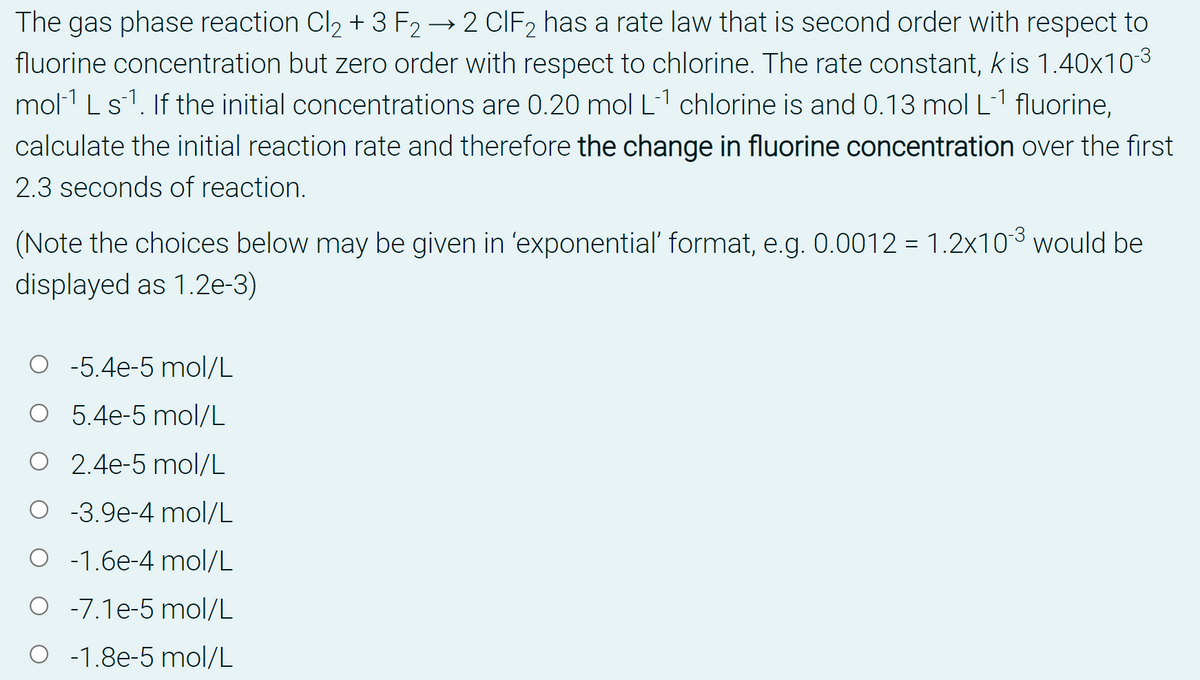The gas phase reaction Cl2 + 3 F2→2 CIF2 has a rate law that is second order with respect to fluorine concentration but zero order with respect to chlorine. The rate constant, kis 1.40x103 mol1 Ls1. If the initial concentrations are 0.20 mol L-1 chlorine is and 0.13 mol L-1 fluorine, calculate the initial reaction rate and therefore the change in fluorine concentration over the first 2.3 seconds of reaction. (Note the choices below may be given in 'exponential' format, e.g. 0.0012 = 1.2x103 would be displayed as 1.2e-3) O -5.4e-5 mol/L O 5.4e-5 mol/L 2.4e-5 mol/L O -3.9e-4 mol/L O -1.6e-4 mol/L O -7.1e-5 mol/L O -1.8e-5 mol/L
The gas phase reaction Cl2 + 3 F2→2 CIF2 has a rate law that is second order with respect to fluorine concentration but zero order with respect to chlorine. The rate constant, kis 1.40x103 mol1 Ls1. If the initial concentrations are 0.20 mol L-1 chlorine is and 0.13 mol L-1 fluorine, calculate the initial reaction rate and therefore the change in fluorine concentration over the first 2.3 seconds of reaction. (Note the choices below may be given in 'exponential' format, e.g. 0.0012 = 1.2x103 would be displayed as 1.2e-3) O -5.4e-5 mol/L O 5.4e-5 mol/L 2.4e-5 mol/L O -3.9e-4 mol/L O -1.6e-4 mol/L O -7.1e-5 mol/L O -1.8e-5 mol/L
Chemistry: Principles and Practice
3rd Edition
ISBN:9780534420123
Author:Daniel L. Reger, Scott R. Goode, David W. Ball, Edward Mercer
Publisher:Daniel L. Reger, Scott R. Goode, David W. Ball, Edward Mercer
Chapter13: Chemical Kinetics
Section: Chapter Questions
Problem 13.50QE
Related questions
Question
The correct answer is -1.6e-4 mol/L but I do not know how to obtain the answer. Please help, thanks.

Transcribed Image Text:The gas phase reaction Cl2 + 3 F2 → 2 CIF2 has a rate law that is second order with respect to
fluorine concentration but zero order with respect to chlorine. The rate constant, kis 1.40x103
mol1 Ls1. If the initial concentrations are 0.20 mol L1 chlorine is and 0.13 mol L1 fluorine,
calculate the initial reaction rate and therefore the change in fluorine concentration over the first
2.3 seconds of reaction.
(Note the choices below may be given in 'exponential' format, e.g. 0.0012 = 1.2x103 would be
displayed as 1.2e-3)
O -5.4e-5 mol/L
O 5.4e-5 mol/L
O 2.4e-5 mol/L
O -3.9e-4 mol/L
O -1.6e-4 mol/L
O -7.1e-5 mol/L
O -1.8e-5 mol/L
Expert Solution
This question has been solved!
Explore an expertly crafted, step-by-step solution for a thorough understanding of key concepts.
Step by step
Solved in 3 steps

Knowledge Booster
Learn more about
Need a deep-dive on the concept behind this application? Look no further. Learn more about this topic, chemistry and related others by exploring similar questions and additional content below.Recommended textbooks for you

Chemistry: Principles and Practice
Chemistry
ISBN:
9780534420123
Author:
Daniel L. Reger, Scott R. Goode, David W. Ball, Edward Mercer
Publisher:
Cengage Learning

Chemistry: The Molecular Science
Chemistry
ISBN:
9781285199047
Author:
John W. Moore, Conrad L. Stanitski
Publisher:
Cengage Learning

Chemistry
Chemistry
ISBN:
9781305957404
Author:
Steven S. Zumdahl, Susan A. Zumdahl, Donald J. DeCoste
Publisher:
Cengage Learning

Chemistry: Principles and Practice
Chemistry
ISBN:
9780534420123
Author:
Daniel L. Reger, Scott R. Goode, David W. Ball, Edward Mercer
Publisher:
Cengage Learning

Chemistry: The Molecular Science
Chemistry
ISBN:
9781285199047
Author:
John W. Moore, Conrad L. Stanitski
Publisher:
Cengage Learning

Chemistry
Chemistry
ISBN:
9781305957404
Author:
Steven S. Zumdahl, Susan A. Zumdahl, Donald J. DeCoste
Publisher:
Cengage Learning


Chemistry: An Atoms First Approach
Chemistry
ISBN:
9781305079243
Author:
Steven S. Zumdahl, Susan A. Zumdahl
Publisher:
Cengage Learning

Chemistry for Engineering Students
Chemistry
ISBN:
9781285199023
Author:
Lawrence S. Brown, Tom Holme
Publisher:
Cengage Learning